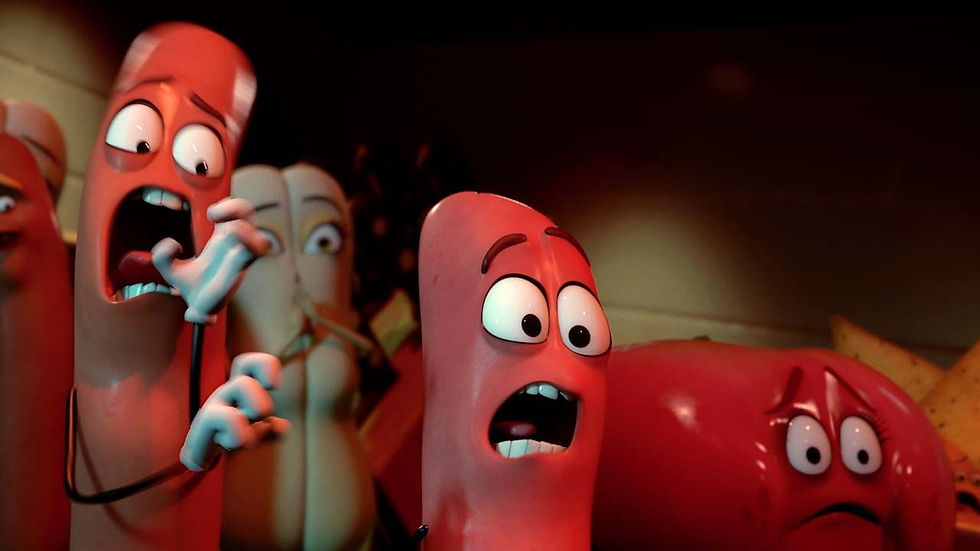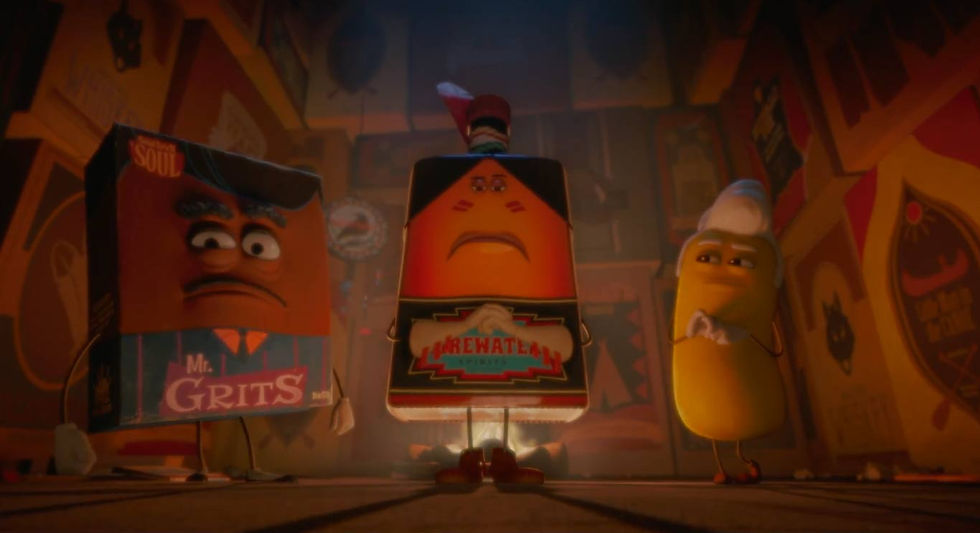When we think of animation, we think of either Disney, DreamWorks, Don Bluth, Hayao Miyazaki, you name it. But we also look at it as a unique, artistic form of expression, conveying images with motion to tell a story in a way that resonates with people emotionally and thematically. But there has been one drawback with it: these days we also have thought of animation as being primarily for children and/or families, part of it stemming from Disney‘s influence on the medium.
Later on, in the 20th century, some artists – starting with the most famous example, Ralph Bakshi – attempted to break the mold by proving that animation can be for adults, too. This envelope was pushed even further in television when Matt Groening made the Simpsons, as did Seth MacFarlane with Family Guy and Matt Stone with South Park. Even though adult animated movies went through an on and off process over the past couple of decades, it seemed that Seth Rogen and the cast and crew behind it have gotten it back into gear again with the controversial Sausage Party.
Here’s the story: inside a grocery store, the food products, all of them anthropomorphic, prepared themselves to be purchased by incoming human shoppers. They believed that once that happens, they would be taken into The Great Beyond, a place of harmony and enlightenment. One day, a hot dog named Frank and a hot dog bun named Brenda have been selected with the rest of their package companions by a shopper before undergoing a cart collision that separated them both from the others. However, Frank discovered from a returned honey mustard that the alleged Great Beyond that everyone in the market has prepared for was a lie. So Frank, along with Brenda and a few new friends, went on a quest to find the truth about what awaited them outside the grocery doors, while the rest of their other purchased friends, including a fellow but misshapen hot dog named Barry, got set for the Great Beyond, not knowing that they would find out about the truth soon enough, too.

During his journey, Frank ran into a trio of nonperishable foods who have inhabited the store for a while longer than anyone else and may have answers to the meaning behind the Great Beyond. Meanwhile during the cart collision, a container named Douche – yep, bear with me on this one; that actually is the character’s name – had his antenna bent over from the fall, and swore revenge on Frank and Brenda for contorting him. In his pursuits, he started going on a killing spree and both drank and ate some of his fellow foodmates for energy. This would all come to a head as Frank and Barry prepared to retaliate against the humans while Douche prepared to retaliate against Frank and Brenda.

When you hear the phrase, “an R-rated animated comedy”, would you have thought of this as a headscratcher at first? Well, it felt like the filmmakers thought so, too, because they have done everything in their power to prove it in the film. For starters, this film contained a lot of profanities, including a hearty amount of F-bombs sprinkled throughout the movie. Heck, the very first word you hear in the movie is the S-bomb.
Second, the movie was rife with sexual innuendos, both visual and verbal. Just look at this poster of Frank and Brenda cuddling each other.

The first time I saw this, I thought to myself, ‘this is pure sexual innuendo waiting to happen.’ This all occurred with more than just the hot dogs and the hot dog buns, though. They were apparent with the other food products and even one of the human characters. I won’t tell you who, you just have to see it and hear it to believe it (if you dare). Of course, not all of it was played comedically, and there were at least one or two moments where the sexual innuendos were ugly to look at, as they were meant to be.
Third, half of all the anthropomorphic food products were portrayed as ethic stereotypes. To lay down a few examples, the tequila characters were represented with Mexican characteristics, the tea bags were seen with monocles and had British accents, the bottles of German sauerkraut were portrayed as Nazis, and there was one moment where a tomato spoke with an Italian accent. There was another character I did not expect to see in the movie named Gum, who was already chewed up by the humans but later found himself in a systematically operated chair with a voice converter, giving him a blatant resemblance to Stephen Hawking. This actually left me speechless. I didn’t know whether to laugh over the resemblance or take umbridge with it. And of course, you have one of the nonperishables, Firewater, who was represented as a Native American with sagely advice and a kazoo smoking pipe. Although – it just hit me – I think part of his stereotypical nature stemmed from his longevity in the store, and he shared that with another nonperishable character, Mr. Grits, who had something of a 50s-inspired design aesthetic to him.

While I’m still on the subject, and while this still may also be a satire in a sense, I ought to talk about the one element of the movie that some critics and audiences have applauded over, but others had issues with. That being that Sausage Party had an existentialist edge and talked about the legitimacy of faith.
Now, this section of the review has spoilers, so avoid it if you haven’t seen it yet.
SPOILER ALERT
In the movie, the food characters placed their faith solely on the humans, or their gods, to take them to the Great Beyond. Granted, they didn’t know that they would be purchased for consumption. In fact, the idea of there being a Great Beyond at all was actually fabricated by Firewater and the other nonperishables to soothe the foods and keep them from anticipating their deaths. Of course, this idea, according to Firewater, started to become manipulated by the food products to support their own views, similar to how we have multiple faiths and multiple countries, all of them differing in ideals. This raised interesting, if also debatable, questions on what we can and should do if we find out that everything we thought we knew was a lie. What if it was all a lie? How would we react to it? How should we react to it? What should we do if we are to take control of our own lives?
While those topics were interesting from the food products’ side of the story, the interpretations from the humans’ side is pretty trippy. You may recall in some of the trailers, if you’ve seen them, that the humans and the food products did actually speak to and understand each other. While that did happen in the movie, it did so for different reasons.
Barry, one of the hot dogs I spoke about, ran into the house of a drug addict named Druggie, who just got into the habit of shooting up bath salts into himself to get high. And only then did Druggie see the food products as they were in their anthropomorphic states. That’s right: the only reason the humans can talk to the food products was because they mistook them for being part of their bath salt hallucinations. Given all that we’ve seen before with humans and animals talking to each other in fiction, this was a clever and weird way of viewing this.
However, getting back to Firewater and the nonperishables, the way that they found out the truth about the humans implied that they found part of it out from smoking Firewater’s pipe.
SPOILERS END
So, if the parallels are anything to judge the film’s take on faith by, the implications felt more negative than they did enlightening. So yeah, there are some things about the movie even I don’t agree with. At the same time, however, I still couldn’t help but chuckle over the thought for little other reason than because of the sheer absurdity of it all.
And, there are some other things that I thought were pretty funny, too. Remember Meat Loaf, the rock artist? Well, not only do you hear one of his songs here in the movie, but you see it sung by Meat Loaf himself...as an actual meat loaf. That visual pun cracked me up a little. The ending especially was hilarious. I won’t give away what happened during then, but let’s just say that it leaned on the fourth wall and was parallel to the struggles the food products dealt with after learning the truth about their ‘faith’.
However, also in the ending, there was a scene that set the already-rampant sexual innuendos in the movie on fire, and it all centered on the food products. It was about as gross and bizarre as it sounds, so you’ve been warned.
But now, we have to wonder, do all of what I’m saying about Sausage Party actually make it a good film? Well, to me, yes. Yes, it does. True, it came with raunchy jokes and questionable outlooks on life, and inevitably, those may turn off some people, but that’s what made the movie a totally different beast from what we’re used to in animation. The Simpsons was met with divided reactions when it first premiered, but now, it is an all-time American classic. Even Snow White was met with disdain at first, too. The first time the idea of a feature-length cartoon was brought up, it resulted in outcries like “there’s no way anyone can sit and watch a cartoon for an hour and a half”. Now, it’s considered one of the greatest movies of all time for its revolutionary ideals.
Those examples, as well as what Sausage Party accomplished, got me thinking: why aren’t there more R-rated animated movies like this one? Well, actually, there are, but most of them are artsy films and often overlooked. It’s rather, why aren’t there more mainstream R-rated animated movies like this one? For all its faults, Sausage Party set a bar at how adult-oriented animated films can be made, and how they could speak to varieties of people, as long as the movie was made with just the right creativity and the right people to work on it with. That’s something that many other filmmakers can take heed with, and this would be very good not just for artistically branching out, but also for the sake of variety.
Fortunately, there are signs hinting that this is indeed possible. For one, Sausage Party did well with critics and even at the box office, with the movie going as far as to dethrone South Park: Bigger, Longer, and Uncut as the highest grossing R-rated animated film ever. Also, Seth Rogen said that he was interested in developing more R-rated animated movies in the future, including a possible sequel for Sausage Party. So yeah, there is some hope yet.
Like I said, Sausage Party was a different animal in the realm of animation, and its humor, creativity, and outlook on human topics broadened the horizons for the medium. And while it may not change how we view religion, it is going to make you think a little differently about how to view food and grocery stores afterwards.
Just... just prepare to see it with an open mind.
My Rating: B+


Comments